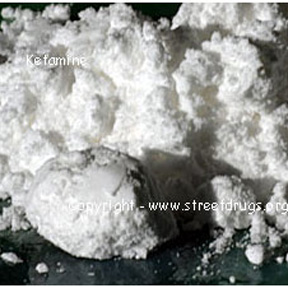
Marketed as a dissociative general anesthetic for human and veterinary use, the only known source of ketamine is via diversion of pharmaceutical products. Recent press reports indicate that a significant number of veterinary clinics are being robbed specifically for their ketamine stock. DEA reporting indicates that a major source of ketamine in the United States is product diverted from pharmacies in Mexico. Ketamine liquid can be injected, applied to smokable material, or consumed in drinks. The powdered form is made by allowing the solvent to evaporate, leaving a white or slightly off-white powder that, once pulverized, looks similar to cocaine. The powder can be put into drinks, smoked, or dissolved and then injected.
Ketamine produces physical effects similar to PCP, with the visual effects of LSD. Users report that it is better than PCP or LSD because the trip lasts an hour or less. Low doses of the drug produce an experience called “K-Land,” a mellow, colorful “wonder world.” Higher doses produce an effect referred to as “K-Hole,” an “out of body,” or “near-death” experience. Due to its dissociative effect, it is reportedly used as a date-rape drug.
Source: DEA, "Club Drugs: An Update,"
Ketamine is similar molecularly to phencyclidine (PCP) and thus creates similar effects including numbness, loss of coordination, sense of invulnerability, muscle rigidity, aggressive/violent behavior, slurred or blocked speech, exaggerated sense of strength, and a blank stare. Since ketamine is an anesthetic, it stops the user from feeling pain, which could lead the user to inadvertently cause injury to himself/herself. Ketamine may relieve tension and anxiety, is purported to be a sexual stimulant, and intensifies colors and sounds.
The effects of a ketamine 'high' usually last an hour but they can last for 4-6 hours, and 24-48 hours are generally required before the user will feel completely "normal" again. Effects of chronic use of ketamine may take from several months to two years to wear off completely. Low doses (25-100mg) produce psychedelic effects quickly. Large doses can produce vomiting and convulsions and may lead to oxygen starvation to the brain and muscles; one gram can cause death. Flashbacks may even occur one year after use. Long-term effects include tolerance and possible physical and/or psychological dependence.